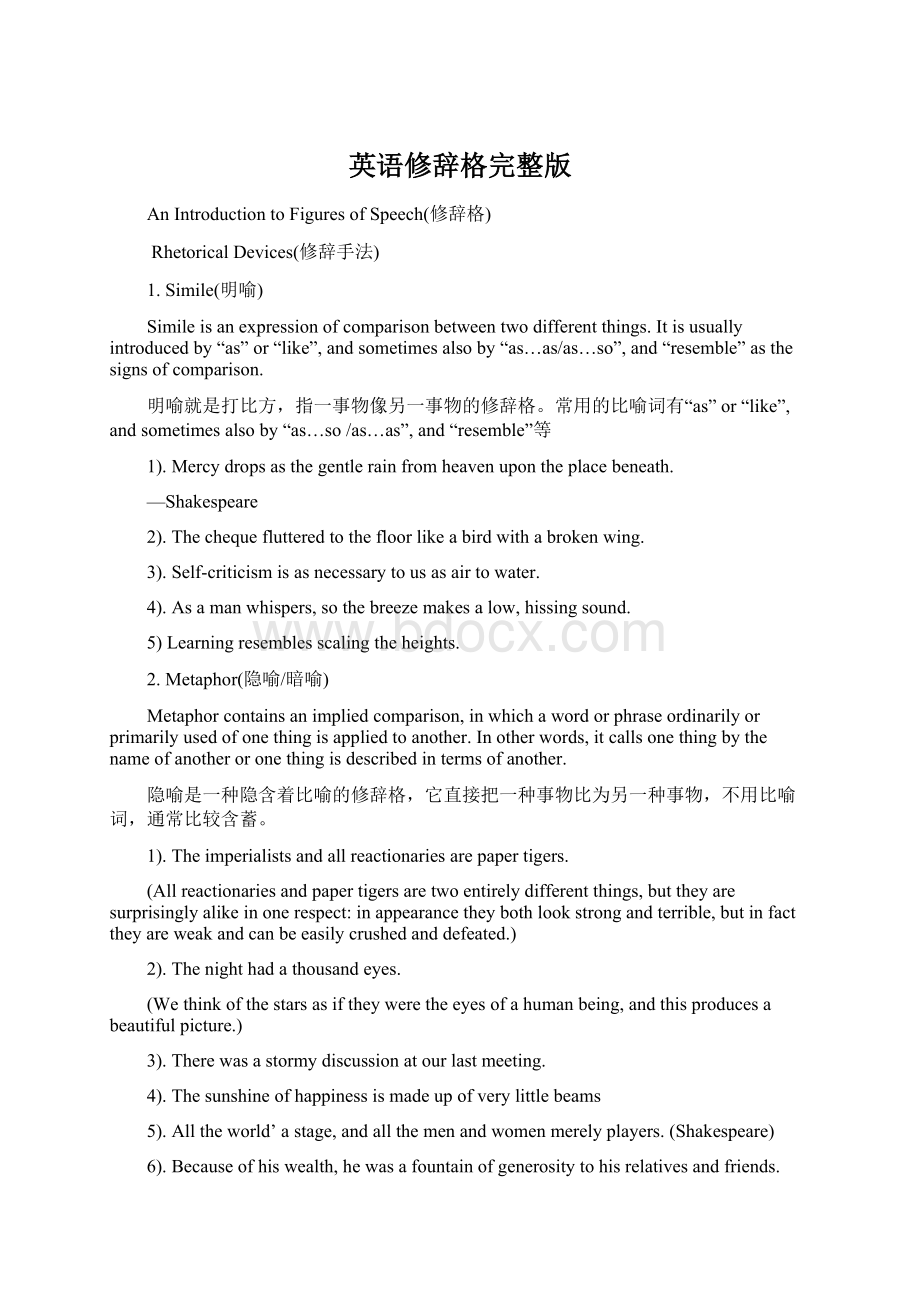英语修辞格完整版.docx
《英语修辞格完整版.docx》由会员分享,可在线阅读,更多相关《英语修辞格完整版.docx(15页珍藏版)》请在冰豆网上搜索。

英语修辞格完整版
AnIntroductiontoFiguresofSpeech(修辞格)
RhetoricalDevices(修辞手法)
1.Simile(明喻)
Simileisanexpressionofcomparisonbetweentwodifferentthings.Itisusuallyintroducedby“as”or“like”,andsometimesalsoby“as…as/as…so”,and“resemble”asthesignsofcomparison.
明喻就是打比方,指一事物像另一事物的修辞格。
常用的比喻词有“as”or“like”,andsometimesalsoby“as…so/as…as”,and“resemble”等
1).Mercydropsasthegentlerainfromheavenupontheplacebeneath.
—Shakespeare
2).Thechequeflutteredtothefloorlikeabirdwithabrokenwing.
3).Self-criticismisasnecessarytousasairtowater.
4).Asamanwhispers,sothebreezemakesalow,hissingsound.
5)Learningresemblesscalingtheheights.
2.Metaphor(隐喻/暗喻)
Metaphorcontainsanimpliedcomparison,inwhichawordorphraseordinarilyorprimarilyusedofonethingisappliedtoanother.Inotherwords,itcallsonethingbythenameofanotheroronethingisdescribedintermsofanother.
隐喻是一种隐含着比喻的修辞格,它直接把一种事物比为另一种事物,不用比喻词,通常比较含蓄。
1).Theimperialistsandallreactionariesarepapertigers.
(Allreactionariesandpapertigersaretwoentirelydifferentthings,buttheyaresurprisinglyalikeinonerespect:
inappearancetheybothlookstrongandterrible,butinfacttheyareweakandcanbeeasilycrushedanddefeated.)
2).Thenighthadathousandeyes.
(Wethinkofthestarsasiftheyweretheeyesofahumanbeing,andthisproducesabeautifulpicture.)
3).Therewasastormydiscussionatourlastmeeting.
4).Thesunshineofhappinessismadeupofverylittlebeams
5).Alltheworld’astage,andallthemenandwomenmerelyplayers.(Shakespeare)
6).Becauseofhiswealth,hewasafountainofgenerositytohisrelativesandfriends.
3.Personification(拟人)
Personificationisafigureofspeechinwhichathing,quality,orideaisrepresentedasaperson.
拟人是把物当作人来描写的一种修辞格。
它变无灵为有灵,使表现对象栩栩如生、活灵活现。
1).theangerofthetempest.
2).thewhisperoftheleaves.
3).Lookatthesmilingmoon.Howbrightsheis!
4).Thethirstysoildrankintherain.
5).Nonepreachesbetterthantheant,andshesaysnothing.
6).Libertyveiledherface,whilethetyrantspoke.
4.Metonymy(借代/转喻/换喻)
Metonymymeansachangeofname.Thethingspokenofandthethingmeantmaybewhollyunlike,buttherelationbetweenthemissuchthatthementionofonesuggeststheother.
转喻是指用一名称来指代与之密切相关的事物。
1).Thekettle(=Thewaterinthekettle)isboiling.
2).Themotherdidherbesttotakecareofthecradle.(=herbaby)
3).Hesucceededtothecrownin1848.
(i.e.becamethesovereignruler)
4).Thepenhasmoreinfluencethanthesword.
(=Thosewhousethepenhavemoreinfluencethanthosewhousethesword)
5).HereadsShakespeare.(=theworksofShakespeare)
6).Nowadaysnoonecanclaimtoscholasticattainments,withoutknowingDarwinandEinstein.(=theTheoryofEvolutionandtheTheoryofRelativity)
7).Afteraday’stravellingwetookarestundertheshade.(=thetree)
8).Manypeopleloverosycheeks.(=children)
5.Synecdoche(提喻/举喻)
Synecdocheisafigureofspeechwhichconsistschieflyinputtingapartforthewholeorthewholeforthepart,andwhichconsistschieflyinputtingtheconcretefortheabstractortheabstractfortheconcrete.
提喻是指以局部代替全体或以全体代替局部,以抽象代替具体或以具体代替抽象的一种修辞格。
1).Thepartforthewhole
1).Howtoearndailybreadbymypenwastheproblem.
(=thenecessariesoflife)(B.Shaw)
2).Thewholeforthepart
2).China(=TheChineseplayers)defeatedJapan(=theJapaneseplayers)inthemen’sworldtable-tennischampionships.
3).Theconcretefortheabstract
3).Itwasthecircumstancesthatdevelopedthepoet(=poetictalent)inhim.
4).Theabstractfortheconcrete.
4).Hehasdonememanykindnesses.(=kindthings)
Note:
Metonymyandsynecdocheareessentiallythesameinprinciple,andthereforethedistinctionbetweenthesetwofiguresisnowregardedasoflittlepracticalvalue.
6.Hyperbole(夸张)
Hyperboleisafigureofspeechwhichgentlyexaggeratesthetruth.Inhyperbole,thingsarerepresentedasgreaterorless,betterorworse,thantheyreallyare.
夸张是指在事实的基础上进行夸大,用来抒发作者或说话人的强烈感情,表达自己的深刻感受。
1).Ihaven’tseenyouforages.
(whileinfactitwasonlytwoweeksagothatyouparted.)
2).Aliecantravelhalfwayaroundtheworldwhilethetruthisputtingonitsshoes.真理刚刚穿上鞋子,谎言就走了大半个世界。
3).HadCleopatra’snosebeenshorter,thewholefaceoftheworldwouldhavebeendifferent.
(Cleopatra“埃及艳后”,美妙绝伦。
她权利欲极强,先为凯撒大帝的情妇,后与安东尼结婚,安东尼失败后,又欲勾引屋大维,没有成功,随以毒蛇噬咬自杀。
此句夸张这个女人的容貌与世界面貌的关系。
)
4).Thefirstlinesofalonggypsypoemsing:
“Whenawomanlovesaman,herbodyhastheodorofathousandappletreesinblossom.Thelonglashesofhereyesfanthefiresofhishearttoflame.”
(KonradBercovici:
TheWisdomoftheIlliterate)
12.Euphemism(委婉语)
Euphemismistheuseofamoreagreeablewordorexpressioninsteadofanindelicate(不当的),harsh(刺耳的),ordepressingone.
“委婉语”源自希腊语“顺耳的话”,即用间接的言词取代生硬语,亦即采用转弯抹角和暗示的说法代替直截了当的话,使说话温和一些,幽默一些,避免不悦耳、不愉快或禁忌语。
1).Yourstatementisincorrect.
(i.e.Yourstatementisfalse.)
2).Hepassedawayatsixthatmorning.(i.e.Hedied.)
3).Hisrelationwithhiswifehasnotbeenveryfortunate.
(i.e.Heoftenquarrelswithhiswife.)
4).Hehadopenedhiseyeswiththesunatdawn,scratched,donehisbusinesslikeadogattheroadside,washedatthepublicfountain.
(破晓,他随着太阳的升起睁开眼睛,瘙痒,像狗一样在路边大小便,在喷泉旁边洗洗脸。
)
(GibortHighet:
DiogenesandAlexander)
13.Onomatopoeia(拟声法)
Onomatopoeiaistheuseofwordstoimitateasoundappropriatetothesense.
1).Thedoorbangedafterhim.(把…砰得关上)
2).Therainpatteredallnight.(雨啪嗒啪嗒地下)
3).Asharprattlewasheardonthewindow,whichmadethechildrenjump.(格格声)
4).Thereweretinkling(叮当声)ofsmallbellsandjingling(叮叮当当)ofbigbellsasthesledgeglidedonthesmoothiceinthestillnessofnight.
十、讽刺(irony)是指用含蓄的褒义词语来表示其反面的意义,从而达到使本义更加幽默,更加讽刺的效果。
Well,ofcourse,Iknewthatgentlemenlikeyoucarryonlylargenotes.
啊,当然,我知道像你这样的先生只带大票子。
店员这句话意在讽刺这位穿破衣的顾客:
像你这样的人怎么会有大票子呢?
名为“gentlemen”实则“beggar”而已。
十一、通感(synesthesia)是指在某个感官所产生的感觉,转到另一个感官的心理感受。
Somebooksaretobetasted,otherstobeswallowedandsomefewtobechewedanddigested.
有些书是应当尝尝滋味的,有些书是应当吞下去的,有少数书是应当咀嚼和消化的。
书是“尝”不出味道的,也是不能“吃”下去将其“消化”掉的。
这里把读书中的精读和泛读,阅读欣赏与吸收知识的感受,用味觉功能和消化功能来表示,心理感受是如此逼真和奇特。
十二、头韵法(alliteration)在文句中有两个以上连结在一起的词或词组,其开头的音节有同样的字母或声音,以增强语言的节奏感。
HowandwhyhehadcometoPrinceton,NewJerseyisastoryofstruggle,success,andsadness.
7.TransferredEpithet(移就)
Thetransferredepithetisaqualifyingadjectivetransferredfromapersontoathingorfromonethingtoanother.
把修饰词转换位置,不再修饰应该由它修饰的词,而修饰一个本不应该由它修饰的词。
1).Hewasengagedinadishonestcalling.(他在忙于欺诈行当)
(i.e.Hewasengagedinacalling,inwhichhewasdishonest.)
2).Thepatientlayallnightonhissleeplesspillow.
(i.e.Thesleeplesspatientlayallnightonhispillow)
3).Heclosedhisbusylifeattheageofsixty.
(i.e.Heclosedhislife,duringwhichhewasbusy.)
4).Thisisthecheapestmarketinthiscountry.
(i.e.Thisisthemarketwherethethingsaresoldatthecheapestprices.)
5).Hansshruggedascornfulshoulder.
(i.e.Hansshruggedhisshoulderwithshowingcontempt.)
6).Shehasexpensivetastesinclothes.
(i.e.Shehastastesinclothes,thepricesofwhichareexpensive.)
8.Antithesis(对照/对偶)
Antithesisisanoppositionorcontrastofwordsorideasinthesamesentence.Itisemphasizedbycontrastingonethingwithanother,ashealthwithsickness,warwithpeace,richeswithpoverty.Inthisfigure,verbsshouldbecontrastedwithverbs,adjectiveswithadjectives,nounswithnouns,etc.
对照(对偶)是把意义相反或相对的语言单位(词语、从句或句子)排列在平行、对称的结构里,语义上形成互相对立或对照的一种修辞格。
1).Flatterybringsfriends;truthbringsfoes.
2).Knowledgemakeshumble;ignorancemakesproud.
3).Toreadwithoutreflectionisliketoeatwithoutdigestion.
4).Falsefriendsareworsethanopenenemies.
5).Nobees,nohoney;nowork,nomoney.
6).Givemeliberty,orgivemedeath.
7).Speechissilver,silenceisgold.
8).NotthatIlovedCaesarless,butthatIlovedRomemore.(不是我不爱凯撒,而是我更爱罗马。
)
9.Oxymoron(矛盾修饰法)
Oxymoronisafigureofspeechwhichcombinesincongruousandapparentlycontradictorywordsandmeaningforaspecialeffect.Itisformedbytheconjoiningoftwocontrasting,contradictoryorincongruousterms.Anunderstandingofoxymoroncanhelpustoenjoymorefullytheimpliedcomplexityofdescriptionsandfeelings.
矛盾修饰法把两个意思完全相反的词或词组搭配在一起来形容一项事物,去揭示事物的矛盾性,造成一种出人意外、引人入胜的效果。
这种修辞方法,语言简练,富有哲理。
1).Painfulpleasure.(悲喜交加)
2).Avictoriousdefeat.(胜利的失败)
3).Athunderoussilence.(此时无声胜有声)
4).Idespise(=lookdownupon)itsveryvastnessandpower.Ithasthepoorestmillionaires,thelittlestgreatman,thehaughtiest(=aggrogant)beggars,theplainest(=notbeautiful,pretty)beauties,thelowestskyscrapers,thedolefulest(=verysad)pleasuresofanytownIeversaw.
——O.Henry
我最蔑视权贵,这里我曾见过最贫穷的百万富翁,最渺小的伟人,最高傲的乞丐,最丑陋的美人,最低矮的摩天大楼,最无趣的乐事。
——欧·亨利
5).Beautifultyrant,fiendangelical,
Dovefeather’sraven,wolfish-raveninglamb,
Despisedsubstanceofdivinestshow,
Justoppositetowhatthoujustlyseems,
Adamnedsaint,anhonorablevillain!
美丽的暴君,天使般的恶魔!
长着鸽子羽毛的渡鸦,嗜杀成性的羔羊!
神圣仪表下面的卑鄙本质!
正是你的外貌的对立面,
该遭诅咒的圣徒,体面的恶棍!
——威廉·莎士比亚
10.Climax(渐强法/层进法/递进法)
Climaxisaseriesofwords,phrases,clausesorsentencesarrangedinorderwithincreasingstrengthorimportance.Theclimaxis,ifskillfullyused,willpromoteforce.
渐强法(层进法、递进法)修辞法是把一系列短语或句子用升级的手法按语势的强度顺序排列,所表达的内容由浅入深,由小到大,由轻到重,由少到多,由弱到强,使语势层层递增,渐进到最高强度。
1).Icame,Isaw,Iconquered.
2).Oneboyisaboy,twoboyshalfaboy,threeboysnoboy.
3).Theaudiencesmiled,chuckled,andfinallyhowled(哄笑).
4).Wecouldnotfindpigeonshere,there,everywhere.
5).B